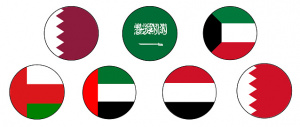Language/Gulf-arabic/Grammar/Adjectives
Hi Gulf Arabic Learners! 😃
In today's lesson we will learn how to use the ADJECTIVES in Gulf Arabic.
Happy learning!
Adjectives are words describing nouns (things or people):
- The car is fast
- The city is small.
➡ In Arabic, there are 2 genders: masculine & feminine.
➡ In Gulf Arabic, the noun and the adjective must agree in gender and number. If you mean "the-town the-small, المدينة الصغيرة il-madiinat is-saghiira"
➡ Nouns, most of the time, precede adjectives.
Finish this lesson and explore these related pages: How to Use "Have", Negation & Conditional Mood.
Examples[edit | edit source]
حجرة[edit | edit source]
Hijra (pl. حجر Hujar) - room
الحجرة الكبيرة[edit | edit source]
il-Hijra il-kebiira – the big/large room
الحجرة الصغيرة[edit | edit source]
il-Hijra iS-Saghiira – the small room
But, if you only say الحجرة صغيرة il-Hijra Saghiira , that would mean "The room is small" (a short descriptive sentence).
Many adjectives become feminine when we add ة –a at the end of the masculine form, e.g.:
الولد الطويل[edit | edit source]
il-walad iT-Taweel – the tall boy (Taweel also means ‘long’.)
البنت الطويلة[edit | edit source]
il-bint iT-Taweela – the tall girl
Occasionally, we make Special Discount Offers available to our waiting list.
To lock in your spot on the waiting list for a discount, and get a reminder, type in your email ⟶
I consent to receive lessons and info on Gulf Arabic - related topics as well as occasional discounts on Gulf Arabic subscriptions.
In Gulf Arabic, duals (see section G.3.2) and plurals of nouns representing inanimate objects are considered grammatically plural or feminine singular, thereby attracting either plural adjectives or feminine singular adjectives. The best way to learn is by example:
شركات كبيرة[edit | edit source]
sharikaat kebiira – big companies
حجر صغيرة[edit | edit source]
Hujar saghiira – small rooms
But you say
الرياييل الزينين[edit | edit source]
ir-rayyaayiil iz-zayiniin (the good men), not ir-rayyaayiil iz-zayna because rayyayiil is not an inanimate object.
Nisba. There are adjectives and nouns, called nisbas, easily derived from nouns by appending ي -i or –iiy (masc.) and ية -iyya (fem.) at the end of the noun. You have already encountered some:
بحريني[edit | edit source]
baHrayni – Bahraini (something or someone from Bahrain)
كويتي[edit | edit source]
kweiti – Kuwaiti (something or someone from Kuwait)
Other examples follow. From:
خارج[edit | edit source]
xaarij – outside
داخل[edit | edit source]
daaxil - inside
we get:
خارجي[edit | edit source]
xaariji – exterior, of the outside
داخلي[edit | edit source]
daaxili – interior, of the inside
وزارة الخارجية[edit | edit source]
wizaara il-xaarijiyya – the Ministry of Foreign Affairs (lit. Ministry the-Exterior; it's an iDaafa where the word الشؤون ish-shu'uun meaning 'affairs' is omitted between wizaara and il-xaarijiyya)
ملابس داخلية[edit | edit source]
malaabis daaxiliyya – underwear (lit. clothes interior)
As the above examples show, the feminine of nisbas is formed by simply adding ة –a to the masculine form. The masculine plural is formed by adding ين –yiin, and the feminine plural, of course, by adding يات -iyyaat for example:
ولد[edit | edit source]
walad (pl. أولاد awlaad) – boy
الأولاد الاماراتيين il-awlaad il-imaaraatiyiin – the Emirati boys
بنت[edit | edit source]
bint (pl. بنات banaat) - girl
البنات الاماراتيات il-banaat il-imaaraatiyaat - the Emirati girls
Other Lessons[edit | edit source]

